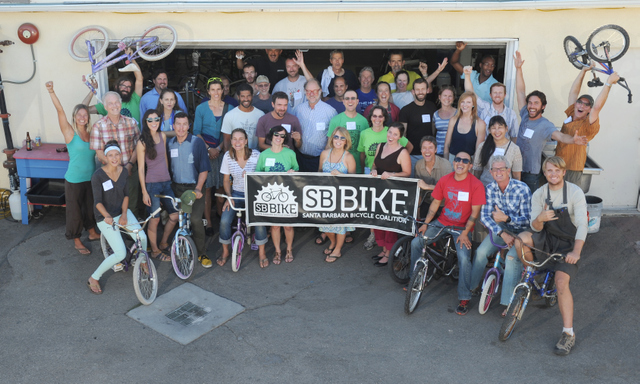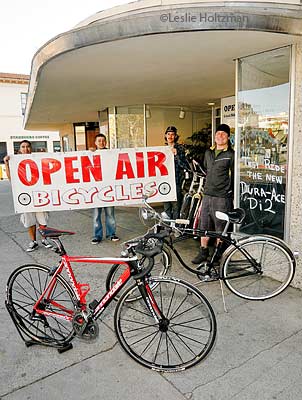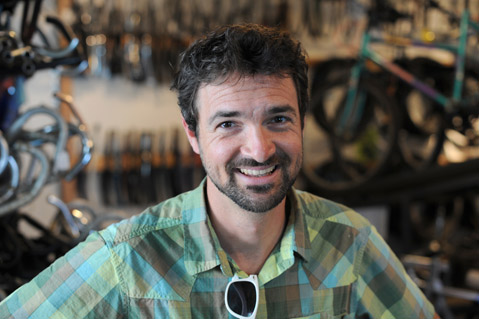Bike Coalition Shifting into High Gear
Escrow Closes on Haley Street Digs; Pioneering Bike Advocate Ralph Fertig Dies

Just as the city has launched a major new bicycle planning initiative, the Santa Barbara Bicycle Coalition has sought to solidify its immediate future and long-term financial viability by purchasing the space it’s been renting for the past 18 months on the 500 block of Haley Street. Had it not secured the property — home to the volunteer-powered do-it-yourself bike repair and bicycle “thrift shop” run by Bici Centro as well as the Bike Coalition’s headquarters — boardmember and longtime bike advocate Matt Dobberteen said the group would have been extremely hard-pressed to find another space anywhere downtown within their financial grasp.
“If we didn’t make this happen, seven years of hard work would have been over, the building would have gone dark, our employees laid off, and our programs canceled,” he said. After a mad scramble of fundraising to raise the $1.2 million asking price, the coalition amassed the funds to close escrow this Wednesday. The deadline was Friday. “We’re ten feet in the air,” exclaimed the usually reserved and understated Dobberteen.

Casting a pall on the celebratory spirit within the bipedal community was the death of Ralph Fertig on Friday, a longtime bicycle advocate in Santa Barbara of such consistency, durability, and selflessness that his presence had achieved an almost geologic aspect. Quiet, unassuming, and absolutely dogged, Fertig made it his mission for more than 20 years to attend any and every transportation planning meeting — no matter how arcane and obscure — to bear witness to the need for more space on the roads for bicycles.
Respectful in style, there was nothing flashy or confrontational about Fertig; he was decidedly not the counter-cultural road warrior. The chances of finding Fertig pedaling along in a Critical Mass ride, shutting down traffic in an act of civil disobedience, hovered between none and nil. With Fertig, the ego was sublimated entirely to the cause, to the work. This — coupled with the intellectual honesty with which he made his case — made it impossible for decision makers to dismiss him out of hand even when it would been exceedingly convenient for them to have done so.
To an uncommon extent, Fertig understood the complicated anatomy of transportation pork; he knew where the money was hidden, what it had been set aside for, and far better than most, he understood the rules and regulations guiding the expenditure of such funds. As undramatic as he may have been, Fertig became the human crowbar, constantly prying money and considerations — even if it was only a seat at the table — out of generations of public works directors and transportation bureaucrats for whom cycling was a recreational pastime and at best an intrusive afterthought. Fertig reportedly died of a stroke in Cottage Hospital after having received chemotherapy for a reoccurring cancer. A bike ride celebrating his life and contributions has been scheduled for August 2.
Without Fertig’s spadework, it’s fair to say the Bicycle Coalition would not have evolved to a point where it could buy outright its own building, an accomplishment rare among Santa Barbara’s legion of nonprofits and advocacy organizations. Dobberteen said the coalition was notified earlier this year by owner David Crown that he was putting the one-story building up for sale. He also told them he wanted to give the organization a shot at buying it. The price was $1.2 million.
For an organization with an annual budget of $300,000, that was a scary stretch. But, Dobberteen said, the group had to act fast. There was no shortage of interest from other real estate investors keen to see if Haley Street could be transformed into a new upscale hip-and-happening zone as has so lucratively been done with the so-called Funk Zone. During the 10 years Crown has reportedly owned the property, he’s struggled with the underground toxic residue left by the dry-cleaning establishment that once occupied the space. But once the Regional Water Quality Control Board gave Crown clearance, the price, Dobberteen said, jumped from $800,000 to $1.2 million.
Dobberteen and two other families of bicycle advocates long associated with the coalition provided the lion’s share of the money. Together, they amassed a pool of $700,000 which they are investing rather than donating, though with the calculated expectation that they will receive a substantially smaller rate of return than they could by investing elsewhere. This approach — investing rather than donating — is part of a new charitable strategy championed locally by the likes of Tom Parker of the Hutton Parker Foundation, whose expertise the Bicycle Coalition relied heavily upon, Dobberteen said, in navigating the many twists and turns of the transaction. “We’re proud to be a part of this,” he said.
Another $300,000 was raised during an intense but relatively short fundraising blitz. And the last $200,000 was raised by securing a short-term loan that has to be paid off in five years. Given the tight cash-flow requirements of the organization, Dobberteen said the coalition will have to continue fundraising to pay that loan off sooner than its due date. The coalition, he said, obtained the loan when Crown notified them three weeks ago that he would not extend the escrow deadline. By that time, Dobberteen said, he’d already gotten a back-up offer on the property for $1.35 million.
The Coalition’s monthly payments will be roughly the same as the $3,000 it now pays in rent. In addition to its own space — 2,200 square feet of interior office and shop use plus about 5,000 square feet of an enclosed exterior courtyard — the coalition will now become landlord to Muddy Waters, a hipster coffee shop and gathering place that also doubles as a nighttime music venue. Muddy Waters’s lease will continue. “We’re excited about what seems to be happening on Haley Street,” said Dobberteen “and we’re excited to be helping Muddy Waters grow their business.”
All this would be just another real estate transaction were it not for the Bicycle Coalition’s expanding profile and growing impact. When the organization started seven years ago, it was an all-volunteer group with no paid staff and an annual budget of about $12,000. About six years ago, the group helped create Santa Barbara’s first “bike kitchen,” following the lead of two-wheeled activists in Los Angeles and other larger cities. There, volunteer mechanics would help assemble new bipedal machines out of old parts and discarded frames that had been donated or salvaged. It served as a cultural hub as well for grease-stained dreamers and schemers hoping to realize fantasies of a car-optional future.
From the start, the group sought to distance itself from cycling’s wealthier and more elitist trappings, embracing instead a very deliberate policy of multiculturalism. The bike kitchen — dubbed Bici Centro — opened shop within the labyrinthine bowels of La Casa de la Raza, a sprawling fortress of a building located on East Montecito Street dedicated to serving the Latino community. The coalition made a point to target the neighborhood’s Latino population for outreach, education, and cheap repairs. Executive Director Ed France is notably bilingual. Demographics and pragmatism drove this policy, not white guilt or gratuitous political correctitude. Who, after all, would be more likely to join the ranks of bicycle commuters than those least able to afford the high price of car ownership?
The coalition has simultaneously reflected and fueled a significant cultural shift among bike riders and bike activists that’s been sweeping not just Santa Barbara but the country. Bike riding was no longer exclusively the austere and grueling activity exclusive almost entirely to white affluent males. Somehow, it became fun, sexy, and stylish. The aesthetic straightjacket of rigid functionality gave way to a playful sense of style for style’s sake that baffled and offended older riders for whom performance — measured down to the last micrometer — was all that mattered. Nothing embodied this shift so starkly as the emergence of the fixie — the one-speed, breaks-optional, knee-cap-crippling masterpiece of tubular minimalism taken well past the breaking point of all logical absurdity.

As gas prices spiked, Santa Barbara workers, like workers across the country, looked for cheaper options. For those living relatively close to their jobs — five miles — the bike became a viable alternative. For those struggling to find the time to work out, the daily commute allowed them to kill two birds with one vehicle. Demographers discovered to their considerable astonishment that as young millennials hit the magic age of 16, they proved to be in no hurry to get their driver’s licenses. And as they’ve aged, this same demographic bulge has proven notably less in a hurry to buy a car. In Santa Barbara, the annual Bike to Work Day celebration — always a limited eat-your-vegetables event in which participants were rewarded with power bars — gave way to the month-long CycleMania, replete with fashion shows, group rides, movies, beer fests, wine tastings, and even — for the erotically curious — screenings of films known as bike porn.
Lurking behind this change was an increase in the city’s bicycle-serving infrastructure, haphazard, incremental, opportunistic, and disconnected as it might have been. The number of striped bike lanes within city limits went from 13 in 1998 to 40 in 2012. Fifty new bike bollards were planted every year. And contrary to the insistent claims of the two anti-bike activists who comprise Cars Are Basic, Santa Barbara bike numbers — while still absolutely low — have increased dramatically. According to the U.S. Census, nearly seven percent of trips to and from work within city limits are taken by bike. Ten years ago, that percentage was 3.4.
In number of bike commutes, Santa Barbara ranks third of all comparably sized cities within the United States and eighth for cities of any size. The bad news — as Omari Fuller, an organizer with the Bicycle Coalition, told the City Council last Tuesday night — is that collisions between cars and bicycles has spiked as well. Fuller held up a large map of the city pockmarked with dots showing where such collisions — 400 in the last three years — had taken place. It looked like it had been used for target practice by someone wielding a shotgun.
Fuller, like Ed France and Sam Franklin — a one-time elected official from the exceptionally bike-friendly city of Amsterdam — were on hand to urge the council to embrace an aggressive public outreach effort proposed by city traffic engineers as a prelude to rewriting the city’s bicycle master plan, now 16 years old. These three advocates comprise three of the Bicycle Coalition’s six paid positions, and now that the organization’s real estate questions have been answered, they’ll now be focusing on the bike plan.
About 18 months ago, the coalition — which, among other things, has provided bike safety instruction to young riders and led bike-light giveaway programs — moved out of La Casa de la Raza, then undergoing considerable financial turmoil. Since moving to the Haley Street location, the Bicycle Coalition — now boasting more than 600 paid members — caught the eye of Trek Bicycle executive John Burke, who had recently moved (at least part-time) to Santa Barbara with his wife. Trek is headquartered in Wisconsin where Burke’s sister is now running as a Democrat for governor.
To an unusual degree among bicycle company executives, Burke has made it his mission to spread the political gospel of commuter cycling. And he’s been willing to dig deep into his pockets to fuel advocates and lobbying efforts throughout the country. Although Burke is hardly the Bicycle Coalition’s only or biggest guardian angel, he is not shy about flapping his wings loudly. Given Santa Barbara’s obvious advantages for cycling, Burke has pointedly wondered why Santa Barbara isn’t far more bike friendly than it is. He has helped underwrite the cost of paid organizers on the coalition’s staff to find out the answer. When the League of American Bicyclists dispatched a team of experts to Santa Barbara to give the city a soup-to-nuts check-up for bicycle friendliness, it was Burke who footed the bill. The League gave Santa Barbara a silver medal ranking but concluded much work needed to be done before it could deem it worthy of the gold.
France and city traffic czar Rob Dayton, who embraces alternative transit strategies with a born-again zeal, sought to set the stage for the new bicycle master plan by explaining that most of the easy accommodations had already been made. Last year, for example, Caltrans — at City Hall’s urging — squeezed a long stretch of Cliff Drive down from four lanes to three and created new bike lanes on both sides of the road with the remains. To date, this has been met with broad acceptance. Likewise, a year ago, City Hall re-striped Haley Street to create a new bike lane, which appears to have performed admirably in providing a long eastbound stretch of bike-friendly road. (That it happens to run right past the Bicycle Coalition headquarters is merely a happy coincidence.) But what about a similar lane for Eastsiders hoping to ride downtown? It doesn’t exist.
The city’s network of bike lanes is filled with gaps and dead ends that leave car-phobic riders stranded in hostile terrain. Plugging such gaps will all but certainly require trade-offs: Some new lane space can be achieved only at the cost of on-street parking. In recent years, questions about traffic policy has been the stuff of such intense political warfare that all sides still suffer from post-traumatic stress. Accordingly, Dayton and the city traffic planners are nervous about pushing beyond what the public will support. To that end, they’ve proposed an exhaustive two-year outreach program involving neighborhood summits, stakeholder confabs, one-on-one interviews, and broader questionnaires. And that doesn’t include all the meetings with the planning commission, the traffic and circulation committee, and the downtown parking committee.

For France and Dayton, this approach provides a much-needed venue for public education, mobilization, and lobbying. “The questions we are facing is how and how much,” said France. “To answer that, we have to think strategically, and by that I mean how does the bicycle fit into a system-wide transportation approach?”
But for a host of reasons, some councilmembers find Dayton’s proposal more exhausting than exhaustive. The pain remains fresh from the five years it took to complete the city’s general plan update, and no one is interested in revisiting the marathon filibuster sessions that process entailed. Councilmember Gregg Hart — an enthusiastic supporter of alternative transit — suggested that the outreach program be half as long as Dayton proposed so that when it comes in at twice its prescribed length, it would wind up being on time. Besides, he argued, real consensus is impossible to achieve, and it’s a waste of time to even try.
Councilmember Dale Francisco was likewise leery, saying he could predict word-for-word the outcome of the public process. Bike advocates would pack each and every gathering — those not so interested wouldn’t show up — and at the end, “the community” would resoundingly express support for more bike lanes. “I can tell you exactly what the conclusion will be right now,” he said, adding, “I can save you $100,000.”
Although Francisco is among the most skeptical of alternative transit plans — in the past he’s described them as “utopian dreams” hatched by idealistic traffic engineers — he himself used to ride 13 miles to and from work on a regular basis. Even so, he suggested that bike advocates should pursue a less ambitious agenda. Expecting people to change how they get to work, he said, might be asking too much. Better to encourage people to ride their bikes while doing errands. Francisco suggested that City Hall would be better advised to spend $30,000 on a poll to get a broader sense of genuine community sentiment.
The problem with that approach, said Mayor Helene Schneider, is that it’s not clear what questions should be asked. The purpose of the community workshops — as agonizing as they can be — is to achieve a clearer sense of what the options are and what the trade-offs might entail. That kind of either/or option, she said, cannot be easily compressed into a 10-minute telephone poll. “We can kind of guess what they’d say: ‘We want safer streets for bicycles and more parking,’” Schneider said.
Schneider noted that the risk with going as fast as Hart wanted is political backlash. In fact, Francisco was first elected to the council as part of intense repercussions generated by the clumsy and politically insensitive manner in which City Hall installed bulb-outs and roundabouts — traffic calming devices in the parlance of traffic engineers. Francisco was the first of a new wave of conservatism that would sweep City Hall and briefly held a council majority.
Ultimately, the council voted 5-to-1 to initiate the public outreach campaign to update the bicycle master plan, with Francisco casting the one vote against. He clarified that he supported revising the plan and made clear his opposition was to the process involved.



